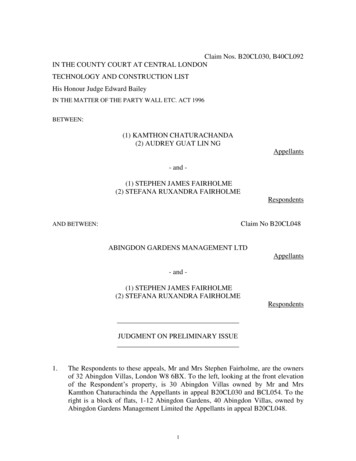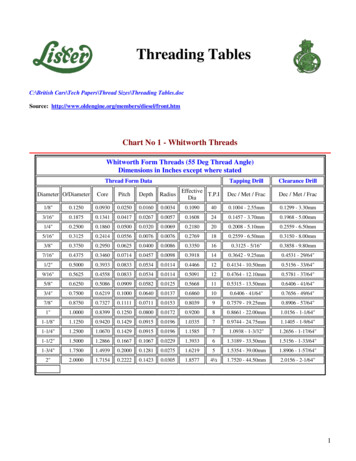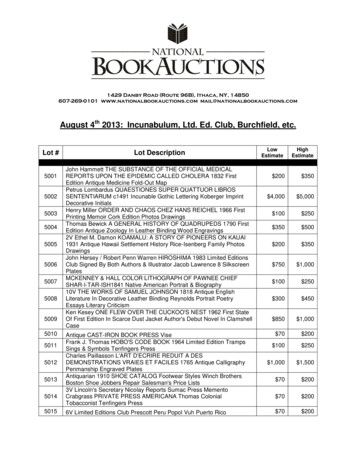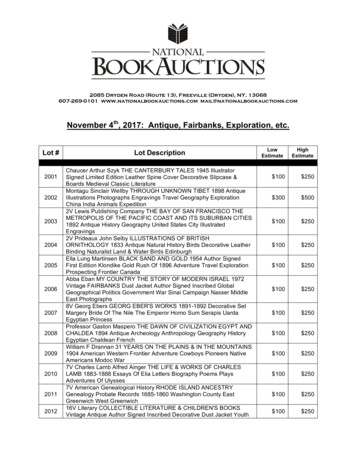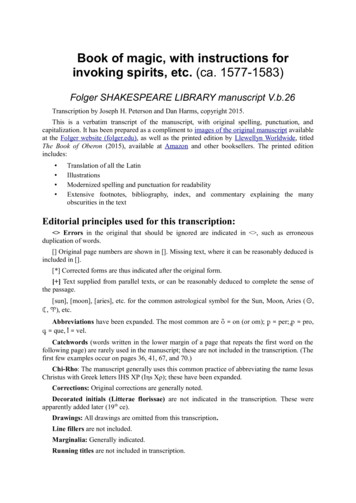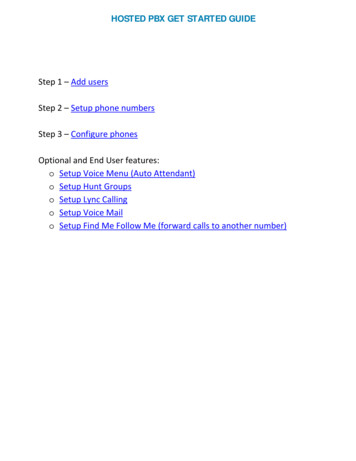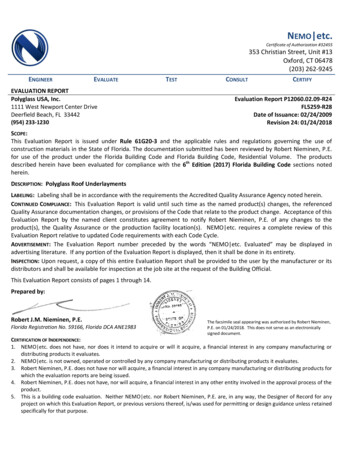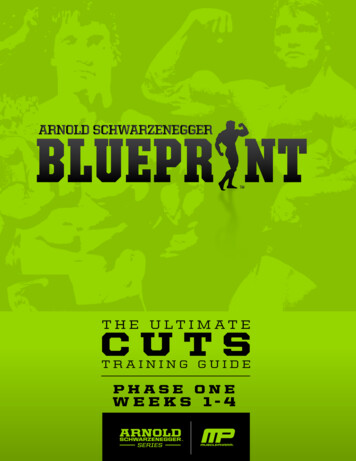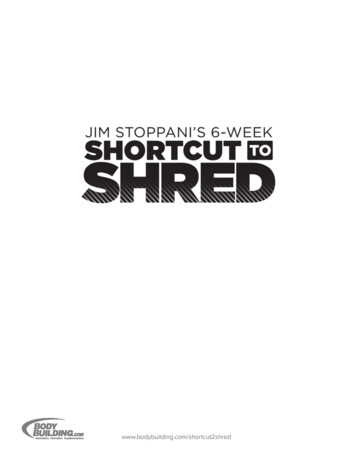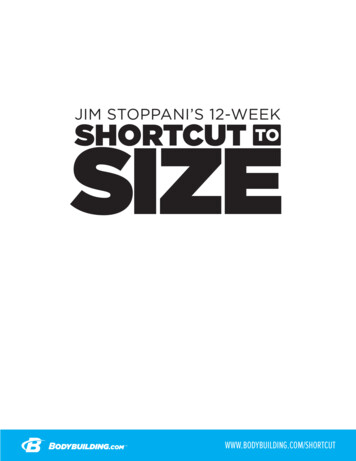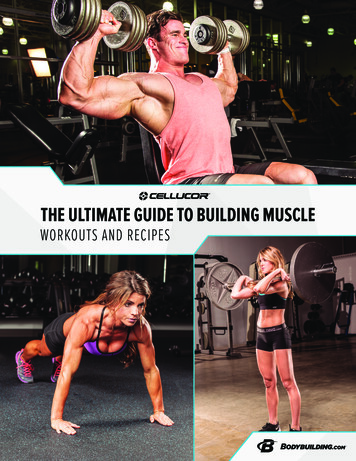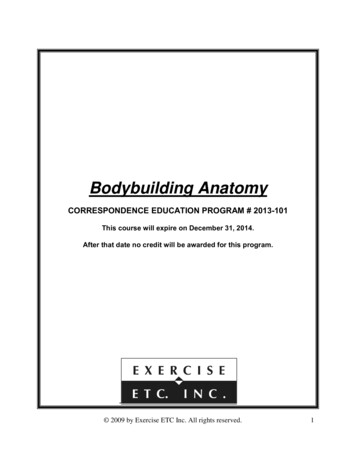
Transcription
Bodybuilding AnatomyCORRESPONDENCE EDUCATION PROGRAM # 2013-101This course will expire on December 31, 2014.After that date no credit will be awarded for this program. 2009 by Exercise ETC Inc. All rights reserved.1
How to Complete this ProgramThank you for choosing an Exercise ETC correspondence program for yourcontinuing education needs. To earn your CECs/CEUs you will need to read theenclosed book. After you have completed the book, take the test that is includedwith your program. Remember to choose the best or most correct answer.Now Available: Instant Grading!When you are ready to submit your test please go to our website at:www.exerciseetc.com On the left side of your screen you will see a blue, verticalbar with a list of options; click on “Administration” and then click“Correspondence Course Answer Sheets.” Choose the title of the test that youare completing and then simply follow all instructions to submit your test.Remember to complete all fields prior to submitting your test.Once you submit your answers your purchase will be verified and your test willbe corrected instantly; if you score at least 70% you will be able to print your CEcertificate immediately. (If you have less than 70% correct, you will need to taketest over again in order to qualify for the CECs/CEUs.) If we are unable to verifyyour purchase you will receive a message requesting that you call our officefor instructions.VERY IMPORTANT: Please make sure you have access to a working printerwhen you submit your test as your CE Certificate must be printed before youclose out your testing session.Good luck! If you have any questions or comments, please feel free to call us anytime at 1-800-244-1344 or e-mail us at: info@exerciseetc.com 2009 by Exercise ETC Inc. All rights reserved.2
Bodybuilding Anatomy- Learning ObjectivesAfter completing the Bodybuilding Anatomy course, the participantwill:1.2.3.4.5.6.7.8.9.10.Learn the anatomy of the shoulders, as well as the primary andsecondary muscles involved in traditional shoulder exercises.Be able to properly execute exercises for the anterior, medial, andposterior deltoid and the rotator cuff.Understand the role of hand positioning, range of motion, andpositioning for traditional shoulder exercises, including possiblevariations of the movements.Learn the anatomy of the chest, understand the three functionaldivisions of the pectoralis major, and be able to give the primaryand secondary muscles involved with traditional chest exercises.Understand proper technique of exercises for three regions of thechest, including trajectory, hand spacing, positioning, and range ofmotion.Learn the anatomy of the upper, middle, and lower back.Know the primary and secondary muscles involved in traditionalback exercises.Understand proper exercise technique for traditional back exercises,including hand spacing, trajectory, body positioning, range ofmotion, and common variations.Learn the anatomy of the upper arm and forearm, as well as theprimary and secondary muscles involved in bicep, tricep, andforearm exercises.Be able to properly execute exercises for the biceps, triceps, andforearms, including hand spacing, grip, trajectory, range of motion,and body positioning, as well as possible variations to the exercises. 2009 by Exercise ETC Inc. All rights reserved.3
11.12.13.14.15.16.Learn the anatomy of the hips, thighs, and calves and the musclesresponsible for all possible movements at the hip, knee, and anklejoint.Know the primary and secondary muscles involved in each exercisefor the hip extenders, quadriceps, hamstrings, and calves.Understand proper exercise technique for traditional exercises forthe hip extenders, quadriceps, hamstrings, and calves, includingfoot positioning, foot spacing, body positioning, range of motion,resistance, and possible variations of the movements.Understand the anatomy and functional movements of theabdominal musculature.Learn proper exercise technique for traditional abdominal exercises,including primary and secondary muscles involved, bodypositioning, range of motion, trajectory, and resistance variables.Learn possible variations to traditional abdominal exercises. 2009 by Exercise ETC Inc. All rights reserved.4
Bodybuilding Anatomy- Course ExaminationFor each of the following questions, circle the letter of the answer that best answers thequestion.1. Which of the following describes horizontal abduction?A.B.C.D.TheTheTheThearmarmarmarmmoves toward the midline of the body.rotates internally toward the midline of the body.moves in the horizontal plane away from the midline of the body.moves behind the body.2. During adduction, the arm movesA.B.C.D.Backward behind the body.Forward in front of the body.Up and out to the side of the body.Toward the side of the body.3. Which of the following is correct?A. The three heads of the deltoid each have their own tendon attachment to thehumerus.B. The three heads of the deltoid have a single tendon attachment to the humerus.C. The anterior deltoid attaches to the acromium.D. The lateral deltoid attaches to the clavicle.4. All of the following are muscles of the rotator cuff exceptA.B.C.D.TheTheTheThesupraspinatus.teres major.infraspinatus.subscapularis.5. The deltoid tendon inserts on the:A.B.C.D.Acromium processClavicleDeltoid tuberosity on the humerusSpine of the scapula 2009 by Exercise ETC Inc. All rights reserved.5
6. When doing a barbell shoulder press, the hands are placed:AB.C.D.Shoulder-width apartSix inches apartHip-width apartAs far apart as possible.7. Which of the following is not a muscle involved in the barbell shoulder press?A Anterior DeltoidB Lateral DeltoidC BicepsD. Triceps8. Which of the following is false regarding the machine shoulder press?A.B.C.D.ItItItItprovides greater stability.allow for the use of momentum by the legsoffers a choice of handgripsis safer.9. Which of the following is not part of the proper execution of the dumbbell shoulderpress?A.B.C.D.Begin with the dumbbells at shoulder level.Press the dumbbells up, stopping the extension before the elbows are locked out.Palms should be facing forward.Lower the dumbbells back down with control until they are at shoulder level.10. Which of the following is an accurate description of hand position in the dumbbellshoulder press?A. Pressing with the palms pronated works only the lateral head of the deltoid.B. Pressing upward with a neutral grip maximizes involvement of the lateral head of thedeltoid.C. Pressing upward with a neutral grip maximizes involvement of the anterior head ofthe deltoid.D. Pressing upward with a supinated grip maximizes involvement of the posterior headof the deltoid.11. Which of the following muscles is not involved in a dumbbell front raise?A.B.C.D.Anterior DeltoidPectoralis MajorTrapeziusBicep 2009 by Exercise ETC Inc. All rights reserved.6
12. A neutral grip or thumbs-up position during the dumbbell front raise emphasizes the:A. Anterior DeltoidB. Lateral DeltoidC. BicepsD. Pectoralis Minor13. Which of the following is incorrect regarding the barbell front raise?A.B.C.D.Start with a pronated shoulder-width grip.Raise the barbell to eye level.Allow slight bend in elbows during the complete range of motionThe movement begins and ends with the barbell at the thighs.14. A narrower grip during the barbell front raise will emphasizes which of the following:A.B.C.D.TheTheTheThelateral deltoidanterior deltoidpectoralis majortrapezius15. All of the following are proper execution of the cable front raise except:A.B.C.D.Use the D-handle attached to low pulley.While facing the weight stack, raise the weight to shoulder level.Elbow should remain stiff or locked out during the complete range of motion.The D-handle should be held with a pronated grip.16. Which of the following is not a muscle involved in the dumbbell lateral raise?A.B.C.D.InfraspinatusLateral DeltoidPosterior DeltoidTrapezius17. Which of the following is an accurate statement regarding the dumbbell lateral raise?A. The trapezius does as much of the work as the lateral deltoid below shoulder level.B. Involvement of the lateral deltoid is maximized when dumbbells are parallel to theground.C. Rotating the dumbbells to a thumbs-up position emphasizes the posterior deltoid.D. The lateral deltoid is the only portion of the deltoid muscle that is involved in thedumbbell lateral raise.18. How can the dumbbell lateral raise be modified to target more of the posterior thethedumbbellsdumbbellsdumbbellsdumbbellsdirectly out to the sides of the body.in front of the body with a forward arc.so that the arc of motion is behind the body.with the hands in neutral thumbs-up position. 2009 by Exercise ETC Inc. All rights reserved.7
19. In the cable one arm lateral raise, it is possible to increase the work done by thetrapezius by:A.B.C.D.Terminating the movement below shoulder height.Raising the handle higher than shoulder height.Focusing on the first 30 degrees of the movementPerforming the raise out to the side and slightly in front of the body.20. Which of the following statements regarding the machine lateral raise is incorrect?A. The machine raise provides a constant resistance throughout the entire range ofmotion.B. A neutral grip externally rotates the shoulder and increases work done by theanterior deltoid.C. The exercise can be done one arm at a time to improve isolationD. The supraspinatus is an assistor if the elbows are raised above shoulder height.21. Muscles involved in the bent-over dumbbell raise include all of the following except the:A.B.C.D.posterior deltoidrhomboidsteres majorsubscapularis22. Which of the following statements regarding the bent-over dumbbell raise is correct:A. Hold the dumbbells with arms straight while bent at the waist in a posterior pelvictilt.B. Raise the dumbbells upward to ear level keeping the elbows locked out.C. Holding the dumbbells with a neutral grip allows the anterior deltoid to beincorporated into the movement.D. Because of the effect of gravity, the resistance is the highest at the highest point ofthe movement.23. Supporting the head on an incline bench while doing the bent-over dumbbell raise will:A.B.C.D.Restrict movement in the spine and decrease the use of momentum.Increase recruitment of the anterior deltoidAllow for more weight to be used in the exerciseRotate the shoulder internally thus increasing the work done by the lateral deltoid.24. Which of the following statements regarding the execution of the bent-over cable raise isincorrect?A. The handles should be attached to a low pulley with the left-side handle in the righthand and the right-side handle in the left hand.B. Stand in the middle of the two cables and bend forward at waist with a flat backkeeping upper body parallel to the floorC. Pull the handles out to the side until hands are above shoulder level.D. Return to start position with right hand in front of left ankle and left hand in front ofthe right ankle. 2009 by Exercise ETC Inc. All rights reserved.8
25. Muscles involved in the reverse cable crossover include all of the following except:A.B.C.D.posterior deltoidanterior deltoidinfraspinatusteres major26. In the reverse cable crossover, to target the posterior deltoid, the arms should move:A.B.C.D.Back and slightly upward.Back and slightly downward.Upward above shoulder heightForward with the torso slightly forward.27. All of the following statements regarding the grip during a machine rear deltoid fly arecorrect except:A.B.C.D.The grip will determine the degree of shoulder joint rotation.Using a pronated grip is the best way to target the posterior deltoid.Using a pronated grip internally rotates the shoulder.Using a pronated grip allows the lateral deltoid to assist with the movement.28. Performing the machine rear deltoid fly one arm at a time:A.B.C.D.Reduces the work done by the trapezius and scapular retractor muscles.Increases the work done by the trapezius and scapular retractor muscles.Decreases the range of motion.Increases the work done by the lateral deltoid.29. Muscles involved in external rotation include all of the following except the:A.B.C.D.DeltoidSubscapularisInfraspinatusTeres minor30. All of the following are correct statements regarding the execution of external rotationexcept:A.B.C.D.TheTheTheThecable is adjusted at waist level.hand moves in a horizontal arcforearm remains parallel to the floor throughout the range of motion.elbow is held 20 degrees away from the body.31. Muscles involved in an incline side raise include all of the following except:A.B.C.D.SupraspinatusInfraspinatusLateral deltoidAnterior deltoid 2009 by Exercise ETC Inc. All rights reserved.9
32. Which of the following statements regarding the pectoralis major is incorrect?A. It has an upper clavicular head and a lower sternal head.B. The clavicular and sternal head each have their own tendon attachment on thehumerus.C. The two heads merge into one tendon that attaches on the humerusD. As the tendon inserts, the tendon twists, attaching the clavicular head below thesternal head.33. How many functional divisions are there in the pectoralis major?A.B.C.D.onetwothreefour34. What is the muscular action of the serratus anterior?A.B.D.E.scapular retractionscapular protractionscapular depressionScapular elevation35. The muscles involved in an incline barbell press include all of the following except:A.B.C.D.Pectoralis majorBiceps brachiiAnterior deltoidTriceps36. Which of the following statements regarding the incline barbell press is incorrect?A.B.C.D.As the incline of the bench increases, the focus shifts higher in the pectoral muscle.The grip is shoulder-width and supinated.An incline of greater than 60 degrees will move the focus to the anterior deltoidThe upper pectoral muscle is worked most efficiently at 30 to 45 degrees to the floor.37. Which of the following regarding the incline dumbbell press is correct?A. Star
Bodybuilding Anatomy- Learning Objectives . After completing the Bodybuilding Anatomy course, the participant will: 1. Learn the anatomy of the shoulders, as well as the primary and secondary muscles involved in traditional shoulder exercises. 2. Be able to properly execute exercises for the anterior, medial, and posterior deltoid and the rotator cuff. 3. Understand the role of hand .
